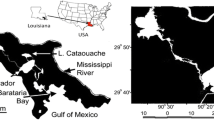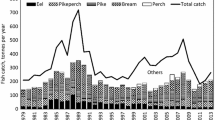Abstract
Top-down control of phytoplankton by zooplankton is possible through reductions in density of zooplanktivorous fish. Little Mere is a shallow lake where the effects of sewage effluent caused such a reduction. This allowed the large-bodied cladoceran, Daphnia magna Straus, to develop huge populations, preventing potentially large algal crops from developing.
Subsequent diversion of the effluent is anticipated to lead to recovery of the fish community, reduced numbers of large-bodied grazers, and increased phytoplankton biomass. Whether the aquatic plant community, present in Little Mere, is resilient to such changes may depend upon whether cyanophytes are favoured, or not.
Similar content being viewed by others
References
Allan, J. D., 1976. Life history patterns in zooplankton. Am. Nat. 110: 165–180.
Bottrell, H. H., A. Duncan, Z. M. Gliwicz, E. Grygiereg, A. Herzig, A. Hillbricht-Ilkowska, H. Kurasawa, P. Larsson & T. Weglenska, 1976. A review of some problems in zooplankton production studies. Norw. J. Zool. 24: 419–456.
Brendelberger, H., 1991. Filter mesh size of cladocerans predicts retention efficiency for bacteria. Limnol. Oceanogr. 36: 884–894.
Briand, F. & E. McCauley, 1978. Cybernetic mechanisms in lake plankton systems: how to control undesirable algae. Nature 273: 228–230.
Brylinsky, M. & K. H. Mann, 1973. An analysis of factors governing productivity in lakes and reservoirs. Limnol. Oceanogr. 18: 1–14.
Burns, C. W., 1968. The relationship between body size of filterfeeding Cladocera and the maximum size of particle ingested. Limnol. Oceanogr. 13: 675–678.
Carvalho, G. R., 1984. Haemoglobin synthesis in Daphnia magna Straus (Crustacea: Cladocera): ecological differentiation between neighbouring populations. Freshwat. Biol. 14: 501–506.
Chaney, A. L. & E. P. Morbach, 1962. Modified reagents for the determination of urea and ammonia. Clin. Chem. 8: 130–132.
Dawidowicz, P., 1990. Effectiveness of phytoplankton control by large-bodied and small-bodied zooplankton. Hydrobiologia 200–201: 43–47.
De Bernardi, R. & G. Giussani, 1990. Are blue-green algae a suitable food for zooplankton? An overview. Hydrobiologia 200–201/Dev. Hydrobiol. 61: 29–41.
Dillon, P. J. & F. H. Rigler, 1974. The phosphorus-chlorophyll relationship in lakes. Limnol. Oceanogr. 19: 767–773.
Fryer, G., 1957. The food of some freshwater cyclopoid copepods and its ecological significance. J. anim. Ecol. 26: 263–286.
Gannon, J. E. & S. A. Gannon, 1975. Observations on the narcotization of crustacean zooplankton. Crustaceana 28: 220–224.
Geller, W. & H. Muller, 1981. The filtration apparatus of Cladocera: Filter mesh-sizes and their implications on food selectivity. Oecologia 49: 316–321.
Grimm, M. P., 1989. Northern pike (Esox lucius L.) and aquatic vegetation, tools in the management of fisheries and water quality in shallow waters. Hydrobiol. Bull. 23: 59–65.
Hutchinson, G. E., 1967. A Treatise on Limnology, 2. J. Wiley & Sons, N.Y., 1115 pp.
Jeppesen, E., M. Søndergaard, E. Mortensen, P. Kristensen, B. Riemann, H. J. Jensen, J. P. Müller, O. Sortkjær, J. P. Jensen, K. Christoffersen, S. Bosselmann & E. Dall, 1990a. Fish manipulation as a lake restoration tool in shallow, eutrophic temperate lakes 1: cross-analysis of three Danish case-studies. Hydrobiologia 200–201/Dev. Hydrobiol. 61: 205–218.
Jeppesen, E., M. Søndergaard, O. Sortkjær, E. Mortensen & P. Kristensen, 1990b. Interactions between phytoplankton, zooplankton and fish in a shallow, hypertrophic lake: a study of phytoplankton collapses in Lake Søbyg»rd, Denmark. Hydrobiologia 191/Dev. Hydrobiol. 53: 149–164.
Kerfoot, W. C., 1980. Commentary: transparency, body size, and prey conspicuousness. In W. C. Kerfoot (ed.), Evolution and Ecology of Zooplankton Communities. The University Press of New England, Hanover (N.H.); Lond.: 609–617.
King, D. L., 1970. The role of carbon in eutrophication. J. Wat. Pollut. Cont. Fed. 42: 2035–2051.
Lammens, E. H. R. R., 1988. Trophic interactions in the hypertrophic Lake Tjeukemeer: top-down and bottom-up effects in relation to hydrobiology, predation and bioturbation during the period 1974–1985. Limnologica (Berlin) 19: 81–85.
Leah, R. T., B. Moss & D. E. Forrest, 1980. The role of predation in causing major changes in the limnology of a hyper-eutrophic lake. Int. Revue ges. Hydrobiol. 65: 223–247.
Lund, J. W. G., C. Kipling & E. D. Le Cren, 1958. The inverted microscope method of estimating algal numbers and the statistical basis of estimations by counting. Hydrobiologia 11: 143–170.
Lynch, M. & J. Shapiro, 1981. Predation, enrichment and phytoplankton community structure. Limnol. Oceanogr. 26: 86–102.
Lynch, M., 1980. Aphanizomenon blooms: alternate control and cultivation by Daphnia pulex. In W. C. Kerfoot (ed.), Evolution and Ecology of Zooplankton Communities. The University Press of New England, Hanover (N.H.); Lond.: 299–304.
Mackereth, F. J. H., J. Heron & J. F. Talling, 1978. Water Analysis: some methods for limnologists. Freshwater Biological Association Scientific Publication No. 36, 120 pp.
McQueen, D. J., 1990. Manipulating lake community structure: where do we go from here? Freshwat. Biol. 23: 613–620.
Mortimer, C. H., 1941. The exchange of dissolved substances between mud and water in lakes. J. Ecol. 29: 280–329.
Mortimer, C. H., 1942. The exchange of dissolved substances between mud and water in lakes. J. Ecol. 30: 147–201.
Moss, B., 1990. Engineering and biological approaches to the restoration from eutrophication of shallow lakes in which aquatic plant communities are important components. Hydrobiologia 200–201/Dev. Hydrobiol. 61: 367–377.
Nadin-Hurley, C. M. & A. Duncan, 1976. A comparison of daphnid gut particles with the sestonic particles present in two Thames Valley reservoirs throughout 1970 and 1971. Freshwat. Biol. 6: 109–123.
Porter, K. G., 1973. Selective grazing and differential digestion of algae by zooplankton. Nature 244: 179–180.
Porter, K. G. & J. D. Orcutt, Jr, 1980. Nutritional adequacy, manageability, and toxicity as factors that determine the food quality of green and blue-green algae for Daphnia. In W. C. Kerfoot (ed.), Evolution and Ecology of Zooplankton Communities. The University Press of New England, Hanover (N.H.);Lond.: 268–281.
Raven, J. A., 1985. The CO2 concentrating mechanism. In W. J. Lucas & J. A. Berry (eds), Inorganic Carbon Uptake by Aquatic Photosynthetic Organisms. Am. Soc. Pl. Physiologists. Waverley Press, Baltimore: 67–82.
Rebsdorf, A., 1972. The Carbon Dioxide System in Freshwater. A set of tables for easy computation of total carbon dioxide and other components of the carbon dioxide system. Freshwater Biological Laboratory, Hillerød, Denmark.
Reynolds, C. S., 1982. Phytoplankton periodicity: its motivation, mechanisms and manipulation. Annual Report of the Freshwater Biological Association 50: 60–75.
Schindler, D. W., 1978. Factors regulating phytoplankton production and standing crop in the world's freshwaters. Limnol. Oceanogr. 23: 478–486.
Schoenberg, S. A. & R. E. Carlson, 1984. Direct and indirect effects of zooplankton grazing on phytoplankton in a hypertrophic lake. Oikos 42: 291–302.
Shapiro, J., 1990. Current beliefs regarding dominance by bluegreens: The case for the importance of CO2 and pH. Verh. int. Ver. Limnol. 24: 38–54.
Shapiro, J. & D. I. Wright, 1984. Lake restoration by biomanipulation: Round Lake, Minnesota, the first two years. Freshwat. Biol. 14: 371–383.
Sprent, J. I., 1987. The Ecology of the Nitrogen Cycle. Cambridge University Press, Cambridge, 151 pp.
Talling, J. F., 1976. The depletion of carbon dioxide from lake water by phytoplankton. J. Ecol. 64: 79–121.
Timms, R. M. & B. Moss, 1 9X4. Prevention of growth of potentially dense phytoplankton populations by zooplankton grazing, in the presence of zooplanktivorous fish, in a shallow wetland ecosystem. Limnol. Oceanogr. 29: 472–486.
Van Donk, E., R. D. Gulati & M. P. Grimm, 1989. Food web manipulation in Lake Zwemlust: positive and negative effects during the first two years. Hydrobiol. Bull. 23: 19–34.
Vollenweider, R. A. (ed.), 1969. A manual on methods for measuring primary production in aquatic environments. Blackwell Scientific, Oxford, 213 pp.
Watson, R. A. & P. L. Osborne, 1979. An algal pigment ratio as an indicator of the nitrogen supply to phytoplankton in three Norfolk Broads. Freshwat. Biol. 9: 585–594.
Zaret, T. M., 1969. Predation-balanced polymorphism of Ceriodaphnia cornuta Sars. Limnol. Oceanogr. 14: 301–303.
Author information
Authors and Affiliations
Rights and permissions
About this article
Cite this article
Carvalho, L. Top-down control of phytoplankton in a shallow hypertrophic lake: Little Mere (England). Hydrobiologia 275, 53–63 (1994). https://doi.org/10.1007/BF00026699
Issue Date:
DOI: https://doi.org/10.1007/BF00026699




